Stanford typed dependencies manual
Marie-Catherine de Marneffe and Christopher D. Manning
Revised for the Stanford Parser v. 3.7.0 in September 2016
September 2008
Please note that this manual describes the original Stanford Dependencies representation. As of ver-
sion 3.5.2, the default representation output by the Stanford Parser and Stanford CoreNLP is the new
Universal Dependencies (UD) representation, and we no longer maintain the original Stanford Depen-
dencies representation. For a description of the UD representation, take a look at the Universal Depen-
dencies documentation at http:/www.universaldependencies.org and the discussion of the enhanced and
enhanced++ UD representations by Schuster and Manning (2016).
1 Introduction
The Stanford typed dependencies representation was designed to provide a simple description of the
grammatical relationships in a sentence that can easily be understood and effectively used by people
without linguistic expertise who want to extract textual relations. In particular, rather than the phrase
structure representations that have long dominated in the computational linguistic community, it repre-
sents all sentence relationships uniformly as typed dependency relations. That is, as triples of a relation
between pairs of words, such as “the subject of distributes is Bell.” Our experience is that this simple,
uniform representation is quite accessible to non-linguists thinking about tasks involving information
extraction from text and is effective in relation extraction applications.
Here is an example sentence:
Bell, based in Los Angeles, makes and distributes electronic, computer and building prod-
ucts.
For this sentence, the Stanford Dependencies (SD) representation is:
nsubj(makes-8, Bell-1)
nsubj(distributes-10, Bell-1)
vmod(Bell-1, based-3)
nn(Angeles-6, Los-5)
prep in(based-3, Angeles-6)
root(ROOT-0, makes-8)
conj and(makes-8, distributes-10)
amod(products-16, electronic-11)
conj and(electronic-11, computer-13)
amod(products-16, computer-13)
conj and(electronic-11, building-15)
1
�
Figure 1: Graphical representation of the Stanford Dependencies for the sentence: Bell, based in Los
Angeles, makes and distributes electronic, computer and building products.
amod(products-16, building-15)
dobj(makes-8, products-16)
dobj(distributes-10, products-16)
These dependencies map straightforwardly onto a directed graph representation, in which words in
the sentence are nodes in the graph and grammatical relations are edge labels. Figure 1 gives the graph
representation for the example sentence above.
Document overview: This manual provides documentation for the set of dependencies defined for
English. There is also a Stanford Dependency representation available for Chinese, but it is not further
discussed here. Starting in 2014, there has been work to extend Stanford Dependencies to be generally
applicable cross-linguistically. Initial work appeared in de Marneffe et al. (2014), and the current guide-
lines for Universal Dependencies (UD) can be found at http://www.universaldependencies.org. For
SD, Section 2 of the manual defines the grammatical relations and the taxonomic hierarchy over them
appears in section 3. This is then followed by a description of the several variant dependency repre-
sentations available, aimed at different use cases (section 4), some details of the software available for
generating Stanford Dependencies (section 5), and references to further discussion and use of the SD
representation (section 6).
2 Definitions of the Stanford typed dependencies
The current representation contains approximately 50 grammatical relations (depending slightly on the
options discussed in section 4). The dependencies are all binary relations: a grammatical relation holds
between a governor (also known as a regent or a head) and a dependent. The grammatical relations are
defined below, in alphabetical order according to the dependency’s abbreviated name (which appears in
the parser output). The definitions make use of the Penn Treebank part-of-speech tags and phrasal labels.
2
Bellbased partmoddistributesnsubjproductsdobjmakesnsubj conj_and dobjAngeles prep_inLos nnelectronic amodbuildingamodcomputeramod conj_andconj_and�
acomp: adjectival complement
An adjectival complement of a verb is an adjectival phrase which functions as the complement (like an
object of the verb).
nsubj
acomp
advmod
She looks very beautiful
advcl: adverbial clause modifier
An adverbial clause modifier of a VP or S is a clause modifying the verb (temporal clause, consequence,
conditional clause, purpose clause, etc.).
“The accident happened as the night was falling”
“If you know who did it, you should tell the teacher”
“He talked to him in order to secure the account”
advcl(happened, falling)
advcl(tell, know)
advcl(talked, secure)
advmod: adverb modifier
An adverb modifier of a word is a (non-clausal) adverb or adverb-headed phrase that serves to modify
the meaning of the word.
“Genetically modified food”
“less often”
advmod(modified, genetically)
advmod(often, less)
agent: agent
An agent is the complement of a passive verb which is introduced by the preposition “by” and does the
action. This relation only appears in the collapsed dependencies, where it can replace prep by, where
appropriate. It does not appear in basic dependencies output.
“The man has been killed by the police”
“Effects caused by the protein are important”
agent(killed, police)
agent(caused, protein)
amod: adjectival modifier
An adjectival modifier of an NP is any adjectival phrase that serves to modify the meaning of the NP.
“Sam eats red meat”
“Sam took out a 3 million dollar loan”
“Sam took out a $ 3 million loan”
amod(meat, red)
amod(loan, dollar)
amod(loan, $)
appos: appositional modifier
An appositional modifier of an NP is an NP immediately to the right of the first NP that serves to define
or modify that NP. It includes parenthesized examples, as well as defining abbreviations in one of these
structures.
appos
appos
Sam , my brother , arrived
Bill ( John ’s cousin )
The Australian Broadcasting Corporation ( ABC )
appos
3
�
aux: auxiliary
An auxiliary of a clause is a non-main verb of the clause, e.g., a modal auxiliary, or a form of “be”, “do”
or “have” in a periphrastic tense.
aux
aux
has
He
should
Reagan
died
auxpass: passive auxiliary
A passive auxiliary of a clause is a non-main verb of the clause which contains the passive information.
leave
“Kennedy has been killed”
“Kennedy was/got killed”
auxpass(killed, been)
aux(killed,has)
auxpass(killed, was/got)
cc: coordination
A coordination is the relation between an element of a conjunct and the coordinating conjunction word of
the conjunct. (Note: different dependency grammars have different treatments of coordination. We take
one conjunct of a conjunction (normally the first) as the head of the conjunction.) A conjunction may
also appear at the beginning of a sentence. This is also called a cc, and dependent on the root predicate
of the sentence.
“Bill is big and honest”
“They either ski or snowboard”
“And then we left.”
cc(big, and)
cc(ski, or)
cc(left, And)
ccomp: clausal complement
A clausal complement of a verb or adjective is a dependent clause with an internal subject which func-
tions like an object of the verb, or adjective. Clausal complements for nouns are limited to complement
clauses with a subset of nouns like “fact” or “report”. We analyze them the same (parallel to the analysis
of this class as “content clauses” in Huddleston and Pullum 2002). Such clausal complements are usually
finite (though there are occasional remnant English subjunctives).
“He says that you like to swim”
“I am certain that he did it”
“I admire the fact that you are honest”
ccomp(says, like)
ccomp(certain, did)
ccomp(fact, honest)
conj: conjunct
A conjunct is the relation between two elements connected by a coordinating conjunction, such as “and”,
“or”, etc. We treat conjunctions asymmetrically: The head of the relation is the first conjunct and other
conjunctions depend on it via the conj relation.
“Bill is big and honest”
“They either ski or snowboard”
conj(big, honest)
conj(ski, snowboard)
cop: copula
A copula is the relation between the complement of a copular verb and the copular verb. (We normally
take a copula as a dependent of its complement; see the discussion in section 4.)
4
�
“Bill is big”
“Bill is an honest man”
cop(big, is)
cop(man, is)
csubj: clausal subject
A clausal subject is a clausal syntactic subject of a clause, i.e., the subject is itself a clause. The governor
of this relation might not always be a verb: when the verb is a copular verb, the root of the clause is the
complement of the copular verb. In the two following examples, “what she said” is the subject.
“What she said makes sense”
“What she said is not true”
csubj(makes, said)
csubj(true, said)
csubjpass: clausal passive subject
A clausal passive subject is a clausal syntactic subject of a passive clause. In the example below, “that
she lied” is the subject.
“That she lied was suspected by everyone”
csubjpass(suspected, lied)
dep: dependent
A dependency is labeled as dep when the system is unable to determine a more precise dependency
relation between two words. This may be because of a weird grammatical construction, a limitation in
the Stanford Dependency conversion software, a parser error, or because of an unresolved long distance
dependency.
“Then, as if to show that he could, . . . ”
dep(show, if)
det: determiner
A determiner is the relation between the head of an NP and its determiner.
“The man is here”
“Which book do you prefer?”
det(man, the)
det(book, which)
discourse: discourse element
This is used for interjections and other discourse particles and elements (which are not clearly linked to
the structure of the sentence, except in an expressive way). We generally follow the guidelines of what
the Penn Treebanks count as an INTJ. They define this to include: interjections (oh, uh-huh, Welcome),
fillers (um, ah), and discourse markers (well, like, actually, but not you know).
Iguazu
is
in Argentina
:)
discourse
dobj: direct object
The direct object of a VP is the noun phrase which is the (accusative) object of the verb.
“She gave me a raise”
“They win the lottery”
dobj(gave, raise)
dobj(win, lottery)
5
�
expl: expletive
This relation captures an existential “there”. The main verb of the clause is the governor.
“There is a ghost in the room”
expl(is, There)
goeswith: goes with
This relation links two parts of a word that are separated in text that is not well edited. We follow the
treebank: The GW part is the dependent and the head is in some sense the “main” part, often the second
part.
goeswith
They come here with out
legal permission
iobj: indirect object
The indirect object of a VP is the noun phrase which is the (dative) object of the verb.
“She gave me a raise”
iobj(gave, me)
mark: marker
A marker is the word introducing a finite clause subordinate to another clause. For a complement clause,
this will typically be “that” or “whether”. For an adverbial clause, the marker is typically a preposition
like “while” or “although”. The mark is a dependent of the subordinate clause head.
mark
Forces engaged in fighting after insurgents attacked
mark
He says that you like to swim
mwe: multi-word expression
The multi-word expression (modifier) relation is used for certain multi-word idioms that behave like a
single function word. It is used for a closed set of dependencies between words in common multi-word
expressions for which it seems difficult or unclear to assign any other relationships. At present, this
relation is used inside the following expressions: rather than, as well as, instead of, such as, because of,
instead of, in addition to, all but, such as, because of, instead of, due to. The boundaries of this class are
unclear; it could grow or shrink a little over time.
“I like dogs as well as cats”
“He cried because of you”
mwe(well, as)
mwe(well, as)
mwe(of, because)
neg: negation modifier
The negation modifier is the relation between a negation word and the word it modifies.
“Bill is not a scientist”
“Bill doesn’t drive”
neg(scientist, not)
neg(drive, n’t)
6
�
nn: noun compound modifier
A noun compound modifier of an NP is any noun that serves to modify the head noun. (Note that in
the current system for dependency extraction, all nouns modify the rightmost noun of the NP – there is
no intelligent noun compound analysis. This is likely to be fixed once the Penn Treebank represents the
branching structure of NPs.)
“Oil price futures”
nn(futures, oil)
nn(futures, price)
npadvmod: noun phrase as adverbial modifier
This relation captures various places where something syntactically a noun phrase (NP) is used as an ad-
verbial modifier in a sentence. These usages include: (i) a measure phrase, which is the relation between
the head of an ADJP/ADVP/PP and the head of a measure phrase modifying the ADJP/ADVP; (ii) noun
phrases giving an extent inside a VP which are not objects; (iii) financial constructions involving an ad-
verbial or PP-like NP, notably the following construction $5 a share, where the second NP means “per
share”; (iv) floating reflexives; and (v) certain other absolutive NP constructions. A temporal modifier
(tmod) is a subclass of npadvmod which is distinguished as a separate relation.
“The director is 65 years old”
“6 feet long”
“Shares eased a fraction”
“IBM earned $ 5 a share”
“The silence is itself significant”
“90% of Australians like him, the most of any country”
npadvmod(old, years)
npadvmod(long, feet)
npadvmod(eased, fraction)
npadvmod($, share)
npadvmod(significant, itself)
npadvmod(like, most)
nsubj: nominal subject
A nominal subject is a noun phrase which is the syntactic subject of a clause. The governor of this relation
might not always be a verb: when the verb is a copular verb, the root of the clause is the complement of
the copular verb, which can be an adjective or noun.
“Clinton defeated Dole”
“The baby is cute”
nsubj(defeated, Clinton)
nsubj(cute, baby)
nsubjpass: passive nominal subject
A passive nominal subject is a noun phrase which is the syntactic subject of a passive clause.
“Dole was defeated by Clinton”
nsubjpass(defeated, Dole)
num: numeric modifier
A numeric modifier of a noun is any number phrase that serves to modify the meaning of the noun with
a quantity.
“Sam ate 3 sheep”
“Sam spent forty dollars”
“Sam spent $ 40”
num(sheep, 3)
num(dollars, 40)
num($, 40)
7
�
number: element of compound number
An element of compound number is a part of a number phrase or currency amount. We regard a number
as a specialized kind of multi-word expression.
“I have four thousand sheep”
“I lost $ 3.2 billion”
number(thousand, four)
number(billion, 3.2)
parataxis: parataxis
The parataxis relation (from Greek for “place side by side”) is a relation between the main verb of a
clause and other sentential elements, such as a sentential parenthetical, a clause after a “:” or a “;”, or
two sentences placed side by side without any explicit coordination or subordination.
“The guy, John said, left early in the morning”
“Let’s face it we’re annoyed”
parataxis(left, said)
parataxis(Let, annoyed)
pcomp: prepositional complement
This is used when the complement of a preposition is a clause or prepositional phrase (or occasionally,
an adverbial phrase). The prepositional complement of a preposition is the head of a clause following
the preposition, or the preposition head of the following PP.
“We have no information on whether users are at risk”
“They heard about you missing classes”
pcomp(on, are)
pcomp(about, missing)
pobj: object of a preposition
The object of a preposition is the head of a noun phrase following the preposition, or the adverbs “here”
and “there”. (The preposition in turn may be modifying a noun, verb, etc.) Unlike the Penn Treebank,
we here define cases of VBG quasi-prepositions like “including”, “concerning”, etc. as instances of pobj.
(The preposition can be tagged a FW for “pace”, “versus”, etc. It can also be called a CC – but we
don’t currently handle that and would need to distinguish from conjoined prepositions.) In the case of
preposition stranding, the object can precede the preposition (e.g., “What does CPR stand for?”).
“I sat on the chair”
pobj(on, chair)
poss: possession modifier
The possession modifier relation holds between the head of an NP and its possessive determiner, or a
genitive ’s complement.
“their offices”
“Bill’s clothes”
poss(offices, their)
poss(clothes, Bill)
possessive: possessive modifier
The possessive modifier relation appears between the head of an NP and the genitive ’s.
“Bill’s clothes”
possessive(John, ’s)
8
�
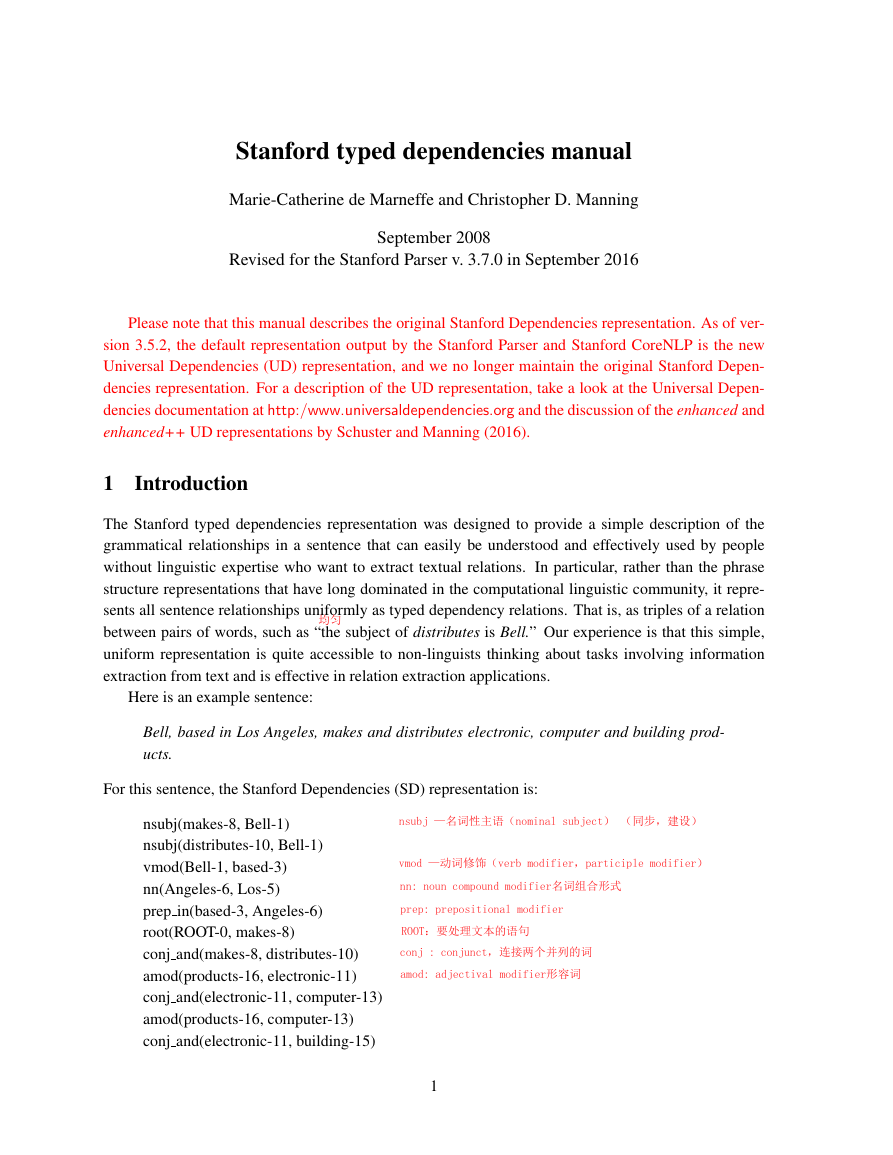
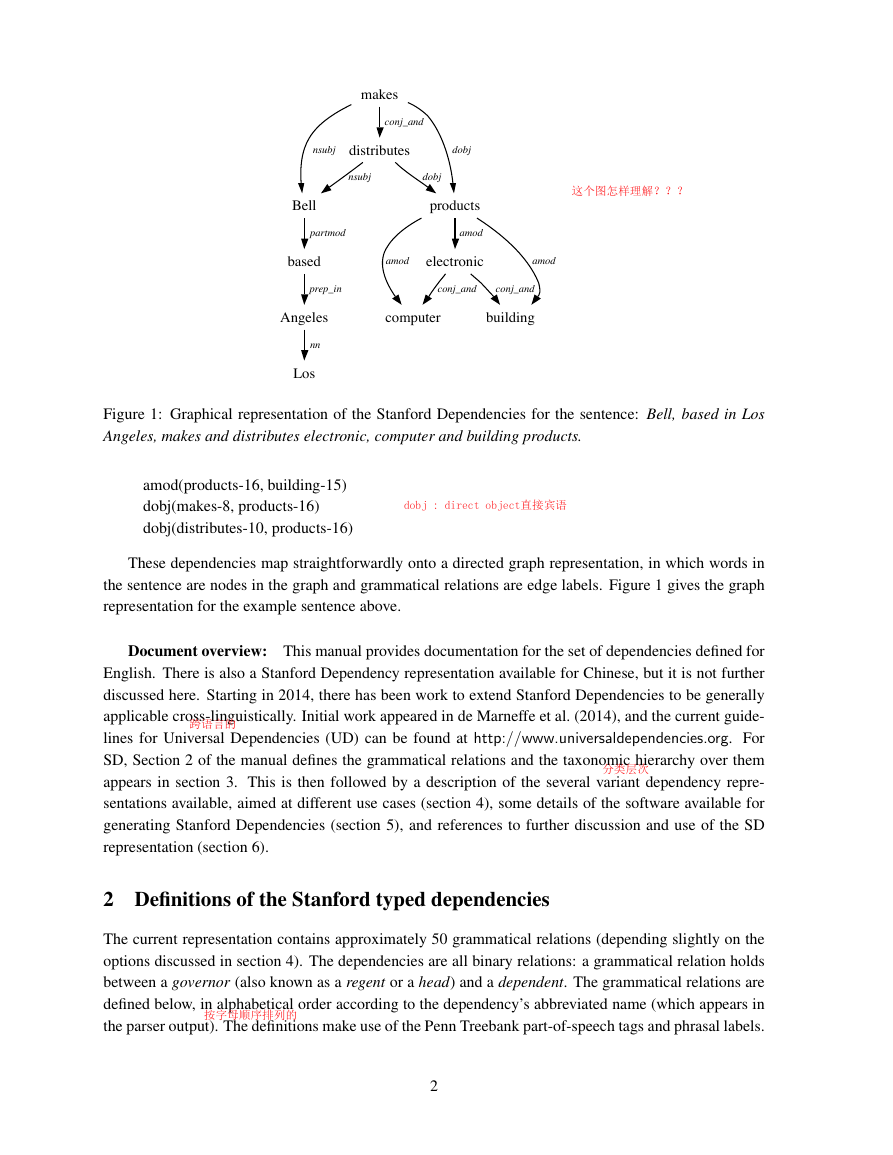
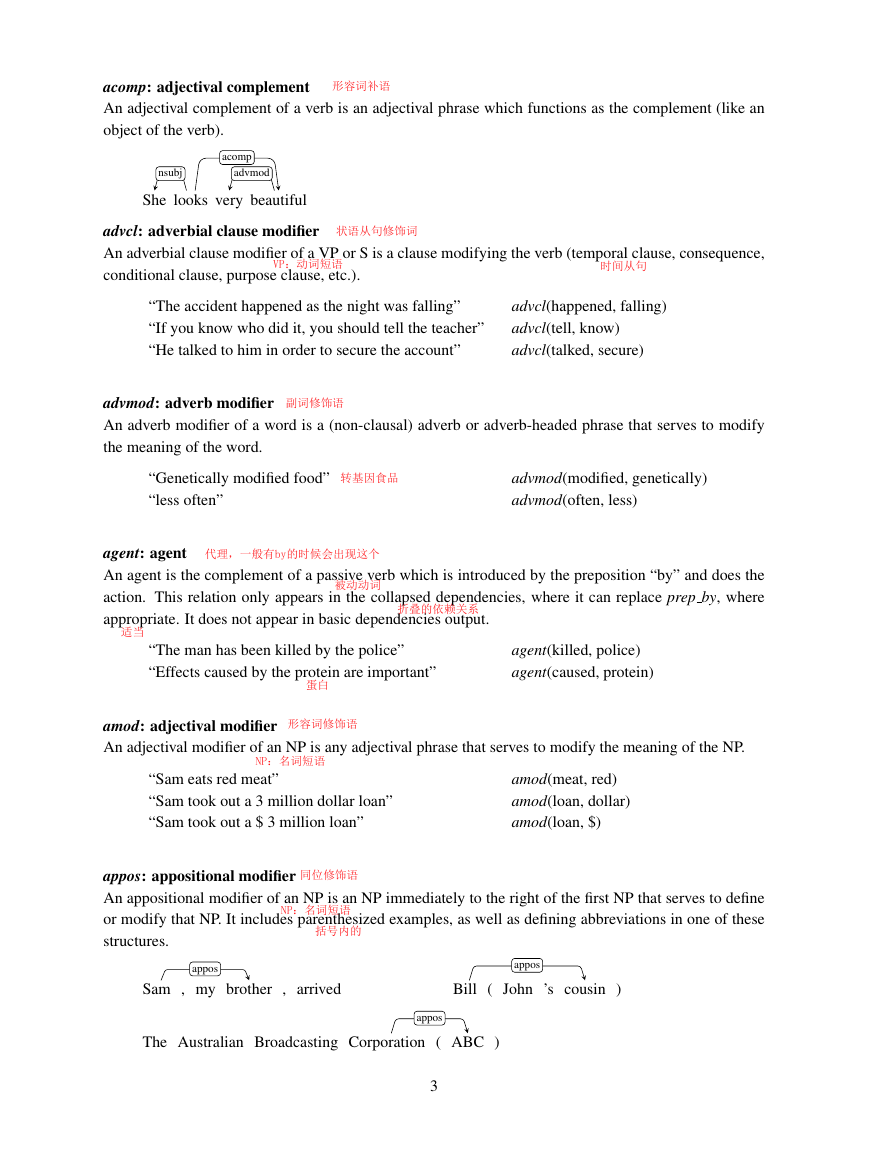
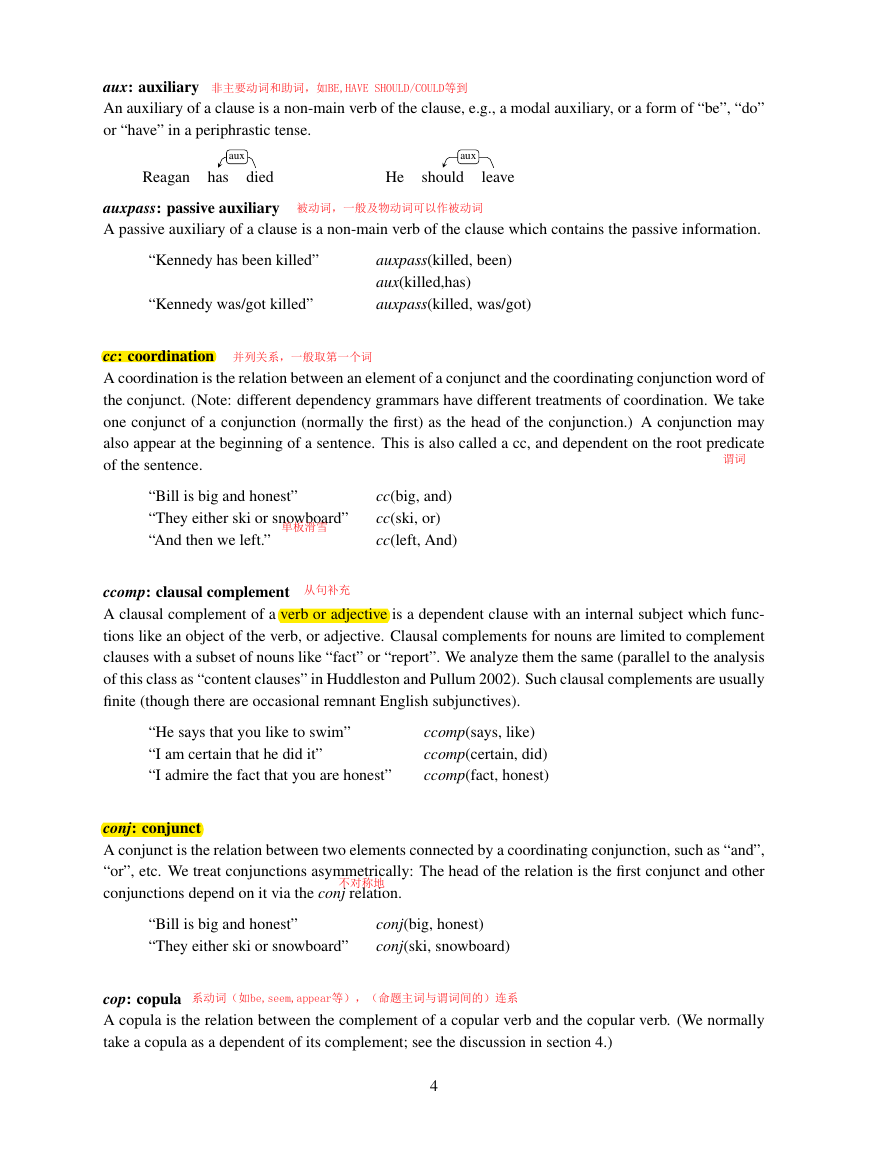
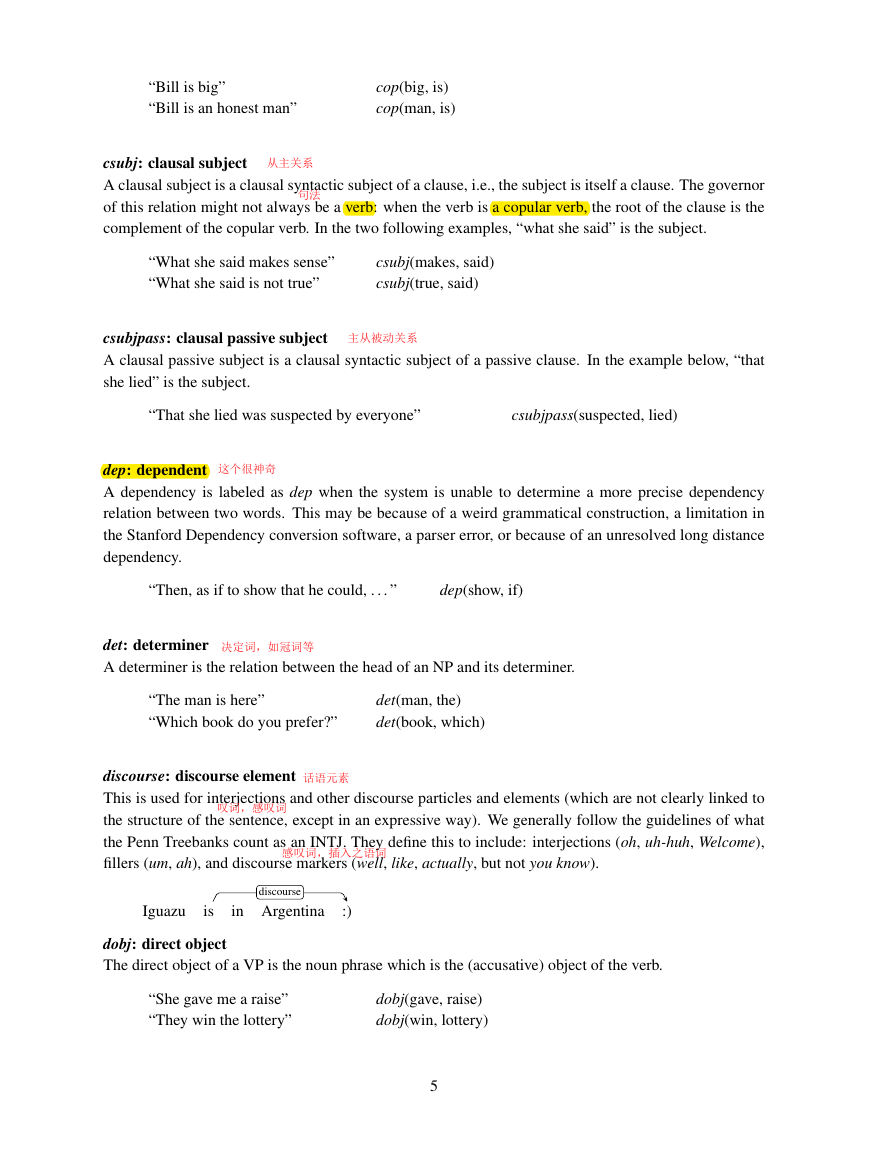
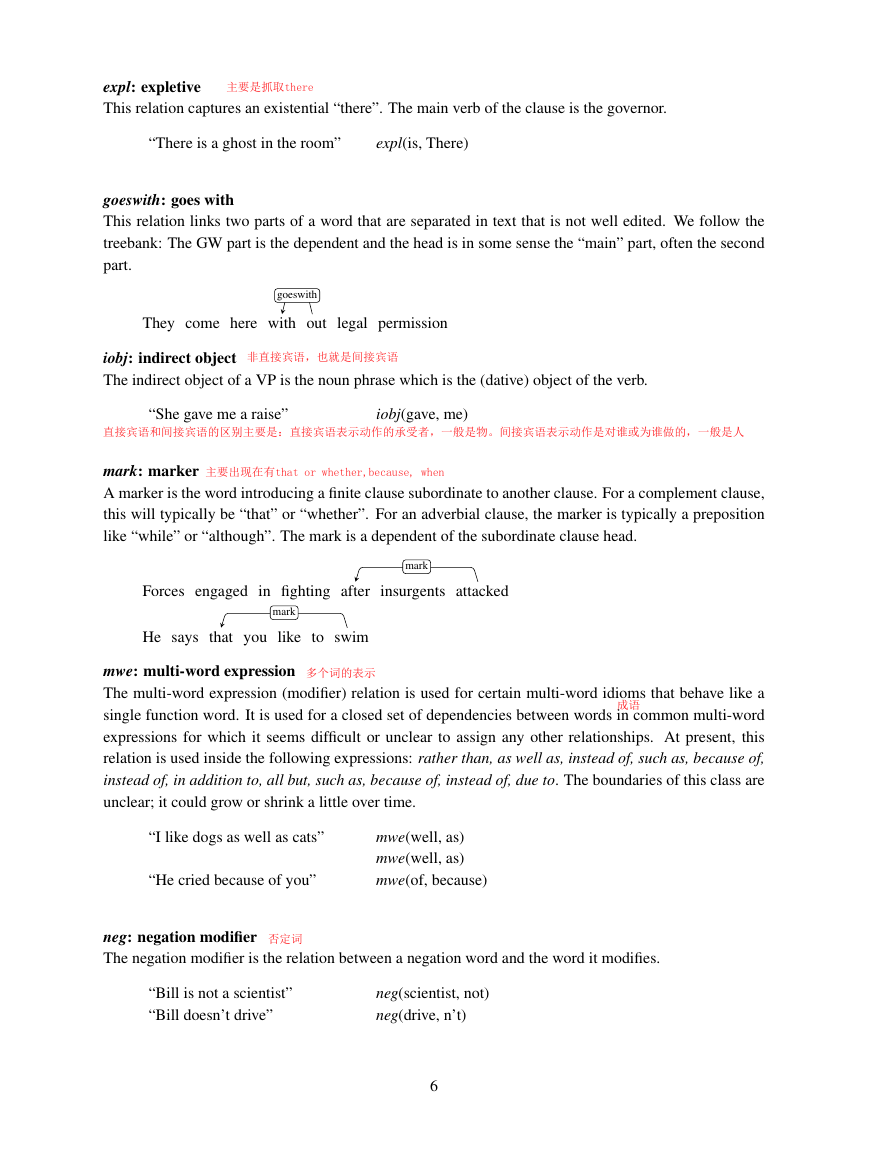
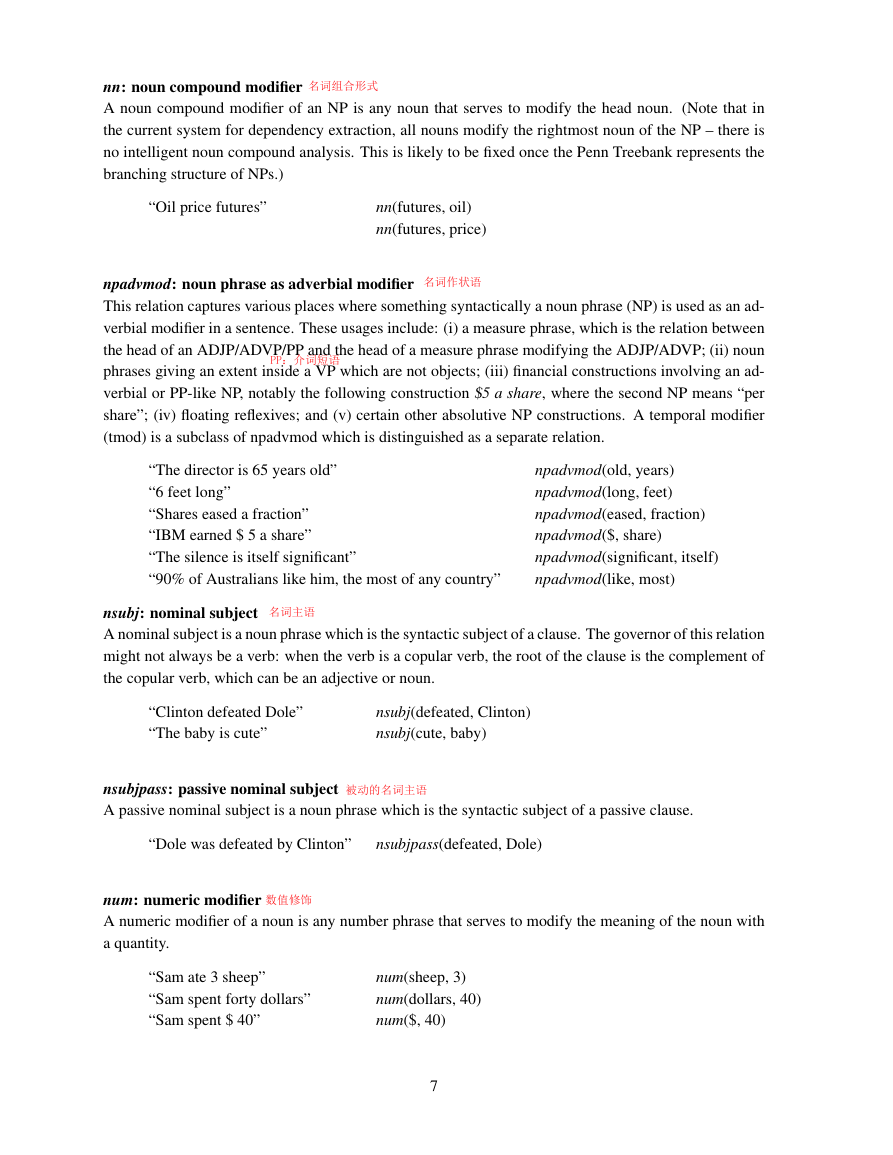
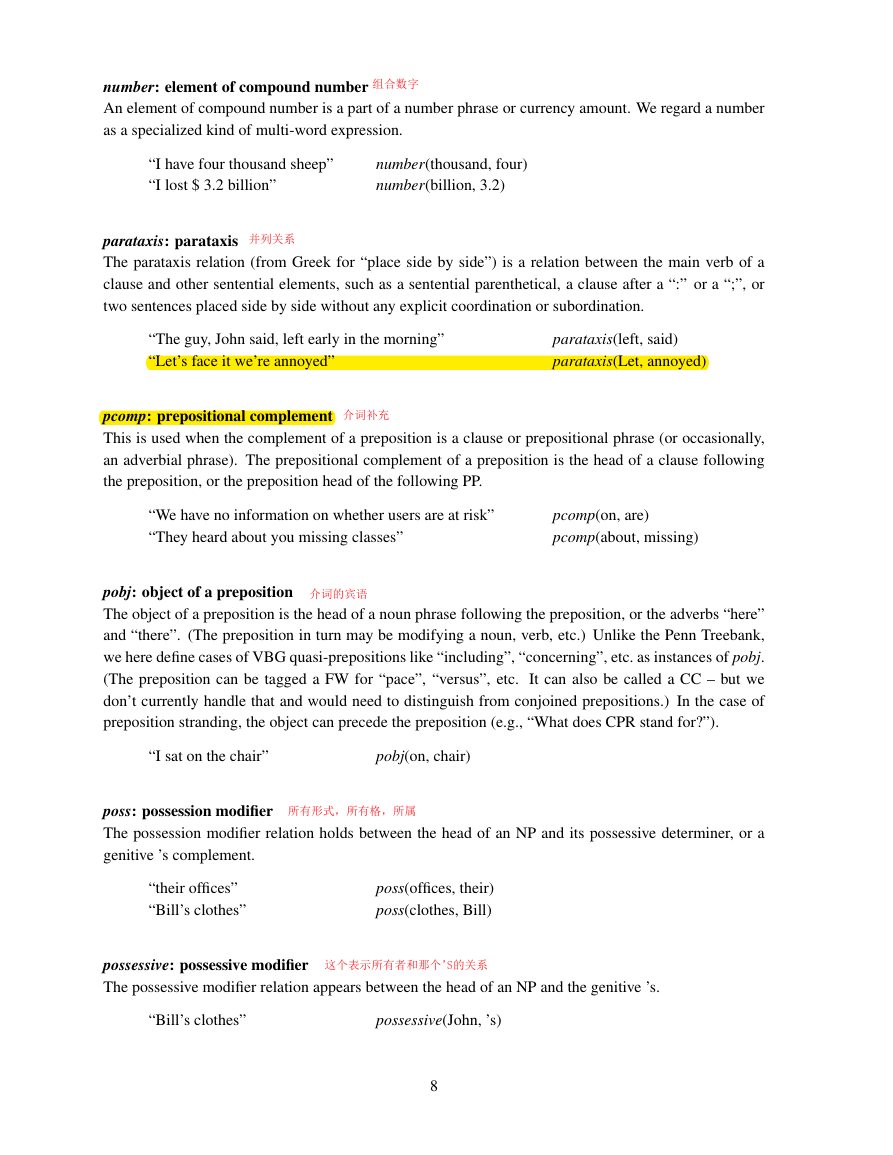








 2023年江西萍乡中考道德与法治真题及答案.doc
2023年江西萍乡中考道德与法治真题及答案.doc 2012年重庆南川中考生物真题及答案.doc
2012年重庆南川中考生物真题及答案.doc 2013年江西师范大学地理学综合及文艺理论基础考研真题.doc
2013年江西师范大学地理学综合及文艺理论基础考研真题.doc 2020年四川甘孜小升初语文真题及答案I卷.doc
2020年四川甘孜小升初语文真题及答案I卷.doc 2020年注册岩土工程师专业基础考试真题及答案.doc
2020年注册岩土工程师专业基础考试真题及答案.doc 2023-2024学年福建省厦门市九年级上学期数学月考试题及答案.doc
2023-2024学年福建省厦门市九年级上学期数学月考试题及答案.doc 2021-2022学年辽宁省沈阳市大东区九年级上学期语文期末试题及答案.doc
2021-2022学年辽宁省沈阳市大东区九年级上学期语文期末试题及答案.doc 2022-2023学年北京东城区初三第一学期物理期末试卷及答案.doc
2022-2023学年北京东城区初三第一学期物理期末试卷及答案.doc 2018上半年江西教师资格初中地理学科知识与教学能力真题及答案.doc
2018上半年江西教师资格初中地理学科知识与教学能力真题及答案.doc 2012年河北国家公务员申论考试真题及答案-省级.doc
2012年河北国家公务员申论考试真题及答案-省级.doc 2020-2021学年江苏省扬州市江都区邵樊片九年级上学期数学第一次质量检测试题及答案.doc
2020-2021学年江苏省扬州市江都区邵樊片九年级上学期数学第一次质量检测试题及答案.doc 2022下半年黑龙江教师资格证中学综合素质真题及答案.doc
2022下半年黑龙江教师资格证中学综合素质真题及答案.doc